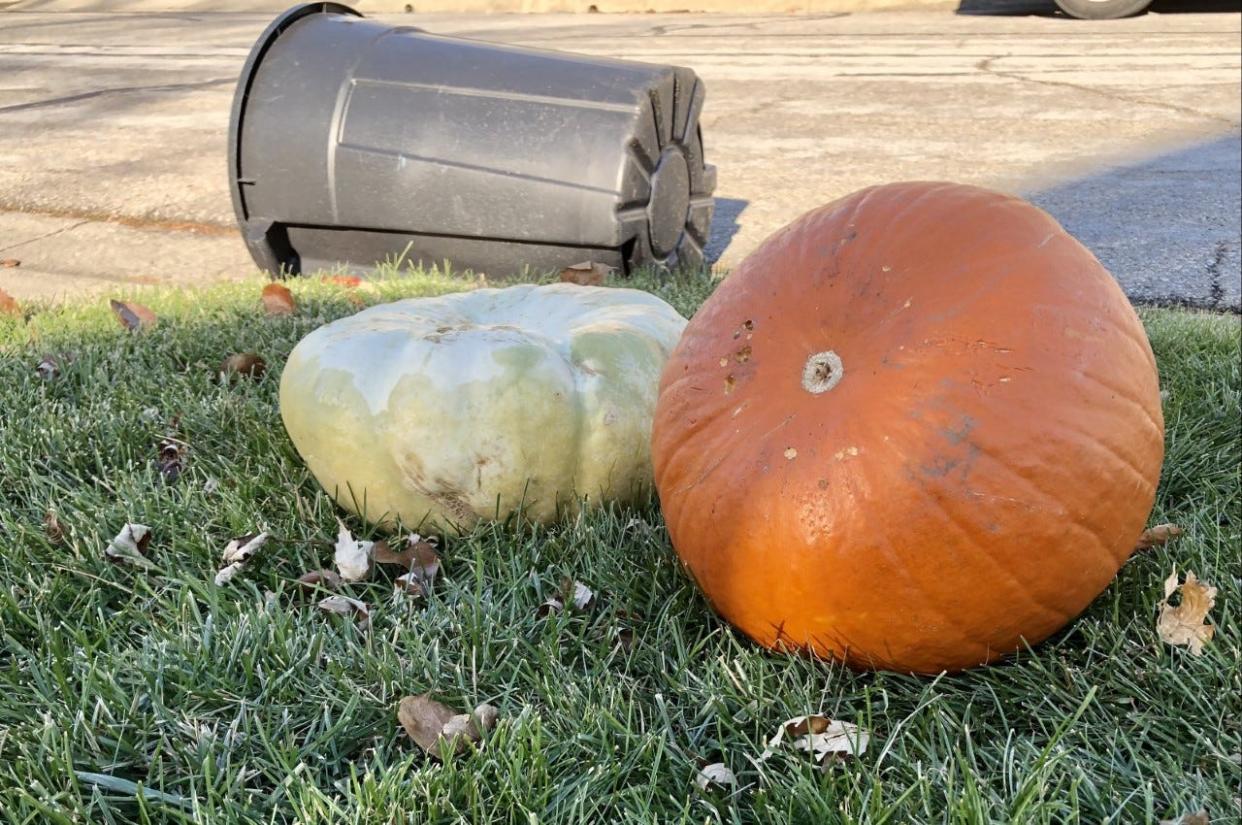Theodore Decker: Pumpkins lead to contemplation of waste, and wastefulness

I realize the nation's 14th-largest city faces bigger crises than the disposal of decorative gourds.
But thanks to the pumpkins tossed back on my curb by the yard-waste pickup crew in my neighborhood, I learned a few things this week.
I happened to be near a window on Tuesday morning when the crew passed by. There appeared to be some sort of delay out in front of my house, but because of my car's positioning I couldn't see exactly what the issue might be.
Yard waste bags were stacked two-deep at the curb, brimming with the bulk of the leaves off my silver maples, as well as the cornstalks and assorted harvest produce I'd broken down to make way for the Christmas decorations.
I confess that it never crossed my mind that pumpkins and gourds were not yard waste. They were all-natural and had been in my yard. My thoughts on the matter had stopped there.
So when I saw them back on the curb, I initially was miffed. The implicit message, I thought, was, "Just landfill these bad boys."
I am far from an ideal low-impact consumer. But I try.

We recycle as best we can. I have a small composter out back, which I fill full of coffee grounds, eggshells, forgotten cucumbers and shredded newspapers. That's where the jack-o'-lanterns go, as they did again earlier this fall.
The composter fills up quicker than it composts, though, so there is downtime built into my system. In the fall, I mix mulched leaves and grass clippings into my vegetable garden, but my trees still produce enough to fill a few dozen bags.
I also go overboard in my Halloween decorations, and a few tweaks of the cornstalks, uncarved pumpkins and gourds extend them through Thanksgiving. The stalks then join the leaves in bags, as did any remaining gourds and pumpkins.
As I said, until this year I never gave the pumpkins-aren't-yard-waste position a moment's thought.
I turned first to the city for insight.
"Recycling yard waste is a win-win in Columbus," the city's website on yard waste collection advises. "It saves the city landfill tipping fees and the collected yard waste is recycled into mulch and other landscaping products."
Right, I thought, so why are the pumpkins back on my curb?
The city directs further questions to Rumpke Waste & Recycling, so I reached out to Gayane Makaryan, a corporate communications manager there.
Makaryan said Rumpke haul's the city's yard waste to Kurtz Bros., where it is turned into assorted mulches and composts. In those recipes, food waste including fruits and vegetables aren't allowed.
So what to do with our harvest-decoration detritus?
Franklin County landfill report: Seems like everyone cleaned out their basements last year
Having covered solid waste as a reporter many years ago, landfilling a pumpkin didn't set right with me. Space in landfills is finite, and organic matter decomposing in them produces greenhouse gases, even though some landfills, Franklin County's included, have gas-to-energy programs designed to capture some of those gases and convert them into usable energy.
The Atlantic reported not too long ago that about a billion pounds of pumpkins end up in landfills each year, largely due to Halloween.
That's about the weight of five aircraft carriers, or probably two winning pumpkins at the Circleville Pumpkin Show.
More: Giant pumpkins take center stage at Circleville weigh-in, despite pandemic
What does Makaryan do?
"I break mine apart and scatter them in our garden," she said. "They are a natural fertilizer and most importantly, cause no harm to wildlife."
If you choose that route, Rumpke recommends:
Remove all candles, lights and decorations from the pumpkin (this would include stickers).
Smash or cut the pumpkin into pieces. You want the pieces to be no larger than 5 inches x 5 inches. If the pumpkin is smaller than that, still break it apart. This helps speed up the decomposition process.
Scatter throughout garden, flowerbeds or dig a hole and cover it with dirt.
The pumpkins most often used in decorating aren't the best eating, although some places have found ways to use them in the fight against hunger.
The Atlantic story noted that other communities have devised inventive ways to recycle pumpkins, including communities that assist in the smashing with pumpkin-launching giant slings, which I suggest Mayor Andrew J. Ginther make a budgetary priority immediately.
Closer to home, communities including Upper Arlington and Dublin that already have food-waste programs in place have begun seasonal pumpkin-recycling programs.
Closer still to my home? The pumpkins are no longer on my curb, or in my trash can.
They got me thinking more about waste, and wastefulness, than I have in a long time.
Both are out back in my vegetable garden awaiting the weekend, and what I have decided will be a smashing good time.
tdecker@dispatch.com
@Theodore_Decker
This article originally appeared on The Columbus Dispatch: Solving the pumpkin problem, one gourd at a time

